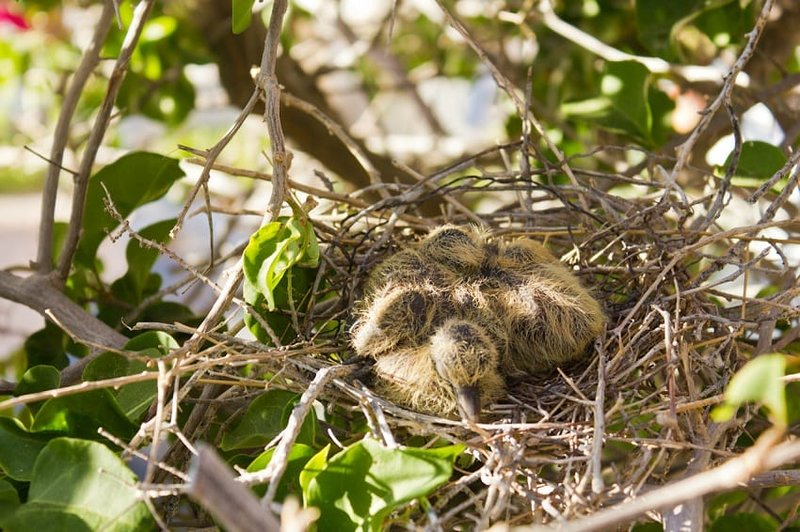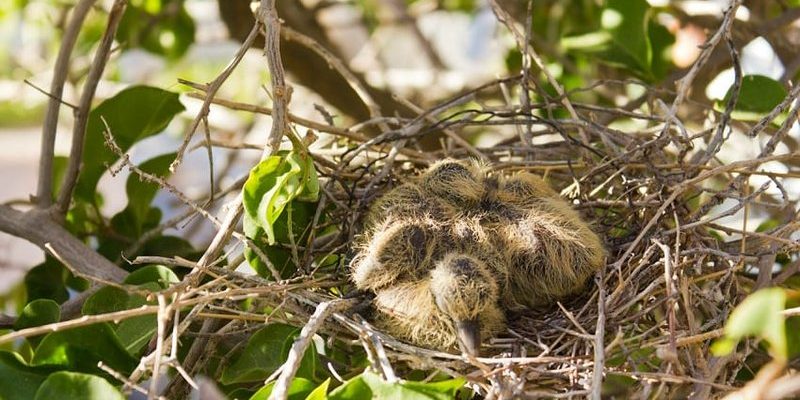
Imagine them as the resourceful apartment dwellers of the bird world, setting up nests in the most unexpected places. Whether it’s an undisturbed corner of a garden or the ledge of a building, the Eurasian Collared Dove knows how to make itself at home. Let’s dive deeper into how they nest, raise their young, and thrive in various environments.
Physical Description of the Eurasian Collared Dove
Before we explore their nesting habits, let’s take a moment to appreciate what these birds look like. The *Eurasian Collared Dove* features a soft grayish-brown color that blends beautifully with their surroundings. They have a distinctive black “collar” or crescent shape on the back of their neck, which gives them their name.
These doves are medium-sized, usually about 12–14 inches in length. Their tails are long and pointed, which makes them easy to identify in flight. When they move, they often glide gracefully, with their wings appearing to flap gently. Honestly, watching them soar can remind you of a leaf floating on a breeze—you can’t help but feel a sense of calm.
You might be wondering how these features help them in their daily lives. Their coloration provides some camouflage against predators, while their size allows them to forage for food effectively. Plus, their strong wings make them great fliers, allowing them to cover large areas in search of sites for nesting.
Nesting Habits of the Eurasian Collared Dove
Alright, let’s get into the good stuff: where and how do these doves build their nests? Eurasian Collared Doves are quite adaptable when it comes to nesting sites. You could find them nestled in a variety of locations, such as trees, shrubs, or even on building ledges. They don’t mind urban environments at all, often taking advantage of human structures for shelter.
When it comes to materials, these doves are pretty resourceful. They typically gather twigs, grasses, and even bits of paper or plastic that they can find. Imagine crafting a warm blanket from scraps—that’s how they approach nest-building. They weave these materials together to create a cozy, secure space for their eggs.
Here’s the thing: the nesting process usually starts with the female laying two eggs. The female will sit on the eggs, keeping them warm, while the male often stands guard nearby. This protective behavior is key to ensuring the safety of their future chicks. It’s a team effort, with both parents playing crucial roles in the nesting process.
The Lifecycle of the Eurasian Collared Dove
The journey of the Eurasian Collared Dove doesn’t end once the eggs are laid. After about 14 to 19 days of careful incubation, the eggs hatch into adorable, fuzzy chicks. Initially, these little ones are quite helpless—eyes closed and covered in downy feathers, they rely entirely on their parents for food and warmth.
As the chicks grow, they start to develop their feathers and, within a few weeks, will be ready to leave the nest. Typically, they’ll fledge around 2 to 3 weeks after hatching. It’s truly a sight to see; the parents encourage them to stretch their wings and take their first flights. You might think of it as their version of sending a child off to school—exciting and a little nerve-wracking!
Within a few months, these young doves will become independent and ready to start nests of their own. The lifecycle of the Eurasian Collared Dove can be quite rapid; often, they can begin breeding just a few months after leaving the nest. This quick maturation contributes to their growing population in various regions.
Feeding Habits and Diet
Now that we’ve covered nesting and lifecycle, let’s talk about what these doves eat. The Eurasian Collared Dove has a varied diet that primarily consists of seeds and grains. They’re often spotted foraging on the ground for food, pecking at sunflower seeds, millet, and even bread crumbs left by humans. Can you imagine them as little scavengers, always on the hunt for their next meal?
They also enjoy fruits and vegetables, adding some color to their menu. Their eating habits play a significant role in their survival and reproduction. By consuming a wide range of food sources, they ensure they’re getting enough nutrition, which is crucial, especially during the breeding season.
Interestingly, these doves have a unique way of drinking water. They tend to take small sips while standing rather than drinking deeply from a water source. This behavior helps them stay hydrated without needing to fly long distances to find water. It’s just another way they’ve adapted to their environment.
Common Predators and Threats
Despite their adaptability and quick breeding cycles, Eurasian Collared Doves face threats from various predators. You might be surprised to learn that their biggest threats include birds of prey like hawks and falcons, as well as domestic pets like cats and dogs. These predators can pose a significant challenge, particularly when the doves are nesting or when the chicks are still vulnerable.
Urban environments bring their own set of challenges too. As cities expand, natural habitats shrink, leaving these birds with fewer safe nesting options. Pollution and human activity can also disrupt their feeding and breeding habits. It’s crucial to be mindful of how our actions as humans can impact their lives.
Interestingly, these doves are also susceptible to disease, which can affect their populations. Keeping an eye on the health of local bird communities can help ensure that Eurasian Collared Doves continue to thrive.
How to Attract Eurasian Collared Doves to Your Yard
Want to invite these beautiful birds into your garden? Attracting Eurasian Collared Doves can be a rewarding experience. Here are some simple steps you can take:
- Provide Food: Set up a bird feeder with seeds like sunflower or millet. Doves love to forage, so scattering seeds on the ground can also work well.
- Fresh Water: Make sure to have a shallow birdbath accessible for these doves to drink and bathe. Clean water is key!
- Safe Nesting Sites: If you have trees or shrubs, consider letting them grow naturally. Dense foliage is perfect for nesting.
- Avoid Pesticides: Reducing chemical use in your garden helps create a healthier environment for all backyard wildlife.
By creating an inviting space, you may just be rewarded with the sight of these gentle birds frolicking in your yard.
The Eurasian Collared Dove is a remarkable bird with fascinating nesting habits and a unique lifecycle. From their adaptability to urban settings to their enchanting behaviors, they bring a sense of joy and peace wherever they appear. By understanding their needs and challenges, we can appreciate these birds even more.
As you enjoy the beauty of nature, consider creating a welcoming environment for these doves in your own backyard. After all, every small action can contribute to the conservation of these charming creatures. So next time you spot a Eurasian Collared Dove, take a moment to admire their grace and resilience in a world that always seems to be changing.

